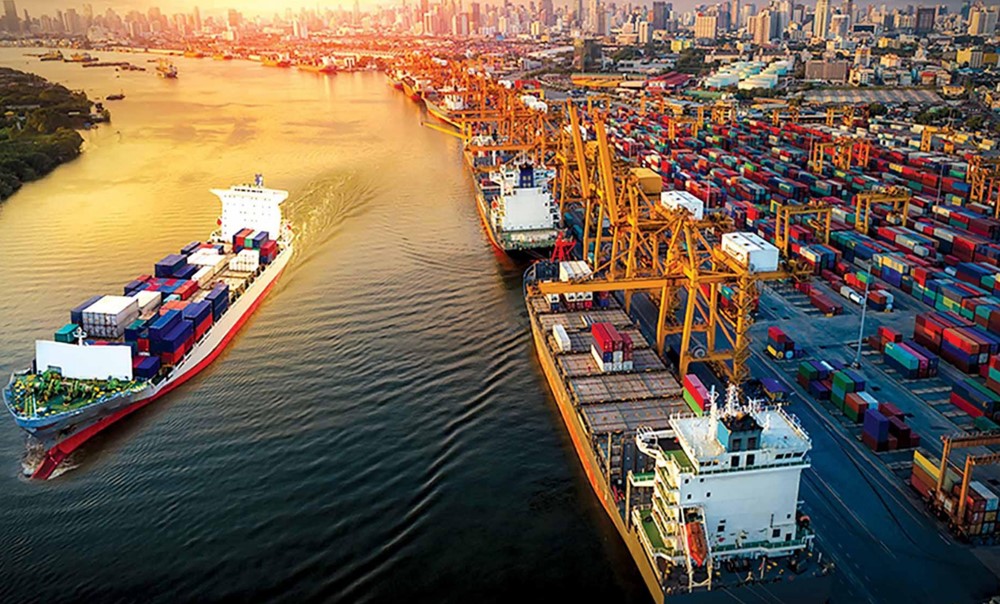GDP per capita to reach 7,500 USD by 2030 in Vietnam
GDP per capita will reach 7,500 USD by 2030 in Vietnam.
GDP per capita to reach 7,500 USD by 2030 in Vietnam
This is the content mentioned in Resolution 90/NQ-CP in 2023 on the Action Program to implement Resolution 81/2023/QH15 on the National Master Plan for the period of 2021-2030, with a vision to 2050, and the Implementation Plan of the National Master Plan for the period of 2021-2030, with a vision to 2050, promulgated by the Government.
Some economic goals are set as follows:
Striving for the average GDP growth rate of the whole country to reach about 7.0%/year in the period of 2021–2030.
By 2030, GDP per capita at current prices will reach about 7,500 USD.
(GDP per capita is calculated by dividing GDP for the year by the average population for the respective year.
Vietnam's GDP per capita in 2022 is about 4,110 USD).

GDP per capita to reach 7,500 USD by 2030 in Vietnam (Internet image)
The proportion in GDP of the service sector is over 50%, the industry - construction sector is over 40%, and the agriculture, forestry, and fishery sectors are less than 10%.
The average growth rate of social labor productivity is over 6.5%/year. The contribution of total factor productivity (TFP) to growth is over 50%.
Bringing into play the advantages of each socio-economic region; focusing on developing two dynamic regions, the North and the South, associated with the two growth poles, Hanoi and Ho Chi Minh City, the North-South economic corridor, the economic corridor Lao Cai - Hanoi - Hai Phong - Quang Ninh, and the economic corridor Moc Bai - Ho Chi Minh City - Bien Hoa - Vung Tau with synchronous and modern infrastructure and a high growth rate, making great contributions to the overall development of the country.
Sustainable urban development by network; urbanization rate reaches over 50%; strive for 3–5 cities on a regional and international level. To build a new rural area to develop comprehensively, sustainably, and in association with urbanization; the percentage of communes meeting the new rural standard is over 90%, of which 50% of the communes meet the newly raised rural standard.
Strongly developing digital infrastructure and data infrastructure to create a foundation for national digital transformation, develop digital government, a digital economy, and a digital society; The share of the digital economy is about 30% of GDP.
Regarding society: firmly maintaining the replacement fertility rate (on average, each woman of reproductive age has 2.1 children); population size reaches about 105 million people.
The HDI remained above 0.7. The average life expectancy is 75 years, of which the healthy life expectancy is at least 68 years. The proportion of agricultural laborers in total social labor dropped to less than 20%.
Improving the quality of jobs and keep the unemployment rate at a reasonable level. The average residential floor area per capita in urban areas is 32 m2. The average green tree area per urban dweller is about 8–10 m2. The ratio of traffic land to urban construction land is about 16–26%.
Developing Vietnamese education to reach an advanced level in the region among the top 10 countries with the best higher education system in Asia. The ratio of university students per ten thousand people is 260. The rate of trained workers with degrees and certificates is 35–40%.
Improving the quality of health services on par with advanced countries in the region. Developing a national network of medical facilities to meet the requirements of caring for, protecting, and improving the health of the entire population, with the goal of equity, quality, efficiency, and international integration. By 2030, reaching the targets of 35 hospital beds and 19 doctors per 10,000 people, the rate of private hospital beds reaching 15%.
Building a healthy cultural environment in the fields of social life. Developing a network of national cultural establishments to ensure the well-performance of the task of preserving and promoting the value of the national cultural identity and promoting the development of the cultural industry. Striving for 100% of provincial administrative units to have 3 types of cultural institutions, including: cultural centers or cultural-art centers, museums, and libraries.
Regarding environment: forest cover rate is stable at 42%; improve the quality of forests; increase the area of nature reserves; protect and restore important natural ecosystems; improve the quality of biodiversity; The area of marine and coastal conservation zones will reach 3–5% of the natural area of the national sea; the area of terrestrial nature reserves reaches 3 million ha.
The rate of urban daily-life solid waste collected and treated according to standards and regulations reaches 95%, of which the rate of treatment through circular economy models is about 50%; The rate of rural daily-life solid waste collected and treated according to standards and regulations reaches 90%; the rate of urban domestic solid waste treated by direct burial is reduced to 10% compared to the collected waste; The recycling rate of organic waste reaches 100% in urban areas and 70% in rural areas.
The rate of hazardous waste collected, transported, and treated according to standards and regulations reached 98%, of which the rate of treated medical waste reached 100%.
The rate of wastewater treatment and reuse in the river basin environment is over 70%. Implement greenhouse gas emission reductions in sectors and fields to strive to quickly achieve the national goal of reducing net emissions to "zero" by 2050.
Regarding infrastructure development: the basic formation of the national infrastructure framework, including North - South road traffic axes (North - South expressway in the East, some sections of North - South expressway in the West, coastal roads), important East - West traffic axes, striving to have about 5,000 km of expressways; gateway seaports with international transshipment functions, large international airports, railway routes connecting with major seaports, urban railways in order to reduce logistics costs; striving to build a number of high-speed railway sections on the North-South route; development of energy infrastructure, information technology, large cities, irrigation infrastructure, environmental protection, natural disaster prevention and control, and adaptation to climate change.
Regarding national defense and security: firmly protect national independence, sovereignty, unity, and territorial integrity; closely and harmoniously combine economic, cultural, and social development with the consolidation of national defense and security; maintain a peaceful environment, political stability; and ensure social order and safety.
Duong Chau Thanh
- Key word:
- GDP
- in Vietnam
- Number of deputy directors of departments in Vietnam in accordance with Decree 45/2025/ND-CP
- Cases ineligible for pardon in Vietnam in 2025
- Decree 50/2025 amending Decree 151/2017 on the management of public assets in Vietnam
- Circular 07/2025 amending Circular 02/2022 on the Law on Environmental Protection in Vietnam
- Adjustment to the organizational structure of the Ministry of Health of Vietnam: Certain agencies are no longer listed in the organizational structure
- Vietnam aims to welcome 22-23 million international tourists in Vietnam in 2025
-

- Objective for GDP growth in 2025 in Vietnam to ...
- 22:54, 02/03/2025
-

- National GDP growth in Vietnam in 2025 reaches ...
- 19:27, 17/01/2025
-

- Emergency response and search and rescue organizations ...
- 10:29, 11/09/2024
-

- Handling of the acceptance results of ministerial ...
- 09:30, 11/09/2024
-

- Guidance on unexploded ordnance investigation ...
- 18:30, 09/09/2024
-

- Notable new policies of Vietnam effective as of ...
- 16:26, 11/04/2025
-
.Medium.png)
- Notable documents of Vietnam in the previous week ...
- 16:21, 11/04/2025
-
.Medium.png)
- Notable documents of Vietnam in the previous week ...
- 16:11, 02/04/2025
-
.Medium.png)
- Notable new policies of Vietnam to be effective ...
- 16:04, 02/04/2025
-
.Medium.png)
- Notable new policies of Vietnam effective from ...
- 14:51, 21/03/2025
 Article table of contents
Article table of contents
